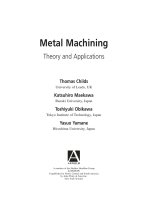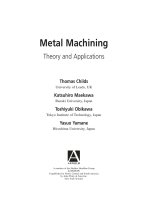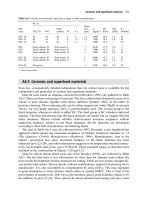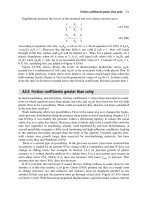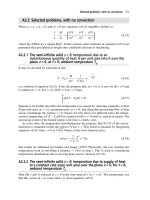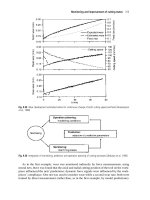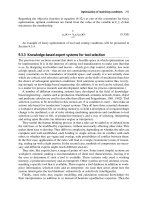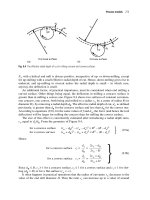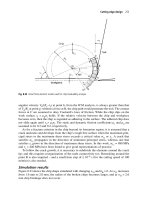Metal Machining - Theory and Applications Episode 1 Part 10 ppt
Bạn đang xem bản rút gọn của tài liệu. Xem và tải ngay bản đầy đủ của tài liệu tại đây (192.41 KB, 20 trang )
To the extent that constraining the variations of p
s
/k
OA″
is valid, equations (6.9b) and
(6.13) may be used to investigate the strain, strain-rate and temperature dependence of
flow in the primary shear zone. Stevenson and Oxley (1969–70, 1970–71) carried out turn-
ing tests on a 0.13%C steel at cutting speeds up to around 300 m/min, measuring tool
forces and shear plane angles. They calculated n from equation (6.l3), assuming C = 5.9.
They calculated k
OA″
from equation (6.9b), and multiplied it by √3 to obtain the equivalent
flow stress on OA″; they calculated the equivalent strain on OA″, assuming it to be half the
total strain; and finally derived s
0
(equation (6.10)). They also calculated the strain rate
and temperature on OA″. Figure 6.11 shows the variations with strain rate and temperature
they derived for s
0
and n. Strain rate and temperature are combined into a single function,
known as the velocity modified temperature, T
MOD
(K):
T
MOD
= T{1 – nlog(e
˘
—
/e
˘
—
0
)} (6.14)
There are materials science reasons (Chapter 7) why strain rate and temperature might be
combined in this way. n is a material property constant that was taken to be 0.09, and e
˘
—
0
is
a reference strain rate that was taken to be 1.
The figure also shows data derived from compression tests on a similar carbon steel and
further data (s
int
) determined from the analysis of secondary shear flow, which will be
discussed in Section 6.3.3. The data for machining and compression tests are not in quan-
titative agreement, but there is a qualitative similarity in their variations with velocity
modified temperature that supports the view that at least some part of the variation of
machining forces and shear plane angles with cutting speed is due to the variation of flow
stress with strain, strain rate and temperature.
There are clearly a number of assumptions in the procedures just described: that all the
variation in (f + l – a) is due to variation in n; that the parallel-sided shear zone model is
adequate (strain rates in practice will vary from the cutting edge to the free surface, as the
actual shear zone width varies); and that C really is a constant of the machining process.
In later work, Oxley investigated the sensitivity of his modelling to variations of C. A
Introducing variable flow stress behaviour 173
Fig. 6.11 Variations of
σ
0
(o) and
n
(•) for a low carbon steel, derived from machining tests, compared with compres-
sion test data (—)
Childs Part 2 28:3:2000 3:12 pm Page 173
change to C causes a change to the hydrostatic stress gradient along the primary shear
plane and hence to the normal contact stress on the tool at the cutting edge, s
n,O
. Adding
the constraint that s
n,O
derived from the primary shear plane modelling should be the same
as that from secondary shear modelling (Section 6.3.3), he concluded – for the same steel
for which he had initially given the value C = 5.9, but over a wider range of feed, speed
and rake angle cutting conditions – that C might vary between 3.3 and 7.1. The interested
reader is referred to Oxley (1989).
6.3.3 Flow in the secondary shear zone
With the partial exception of slow speed cutting tests like those of Roth and Oxley
(Figure 6.8), visioplasticity studies have never been accurate enough to give informa-
tion on strain rate and strain distributions in the secondary shear zone on a par with the
level of detail revealed in the primary shear zone. Certainly at high cutting speeds, grids
or other internal markers necessary for following the flow are completely destroyed.
Nor is there any way, equivalent to applying equation (6.13) in the primary zone, of
deducing the strain hardening exponent n for flow in the secondary shear zone. So, even
if a flow stress could be deduced for material there, the extraction of a s
0
value (equa-
tion (6.10)) and the estimation of a T
MOD
value for it might be thought to be impracti-
cal. Yet Figure 6.11 contains, in the variation of s
int
with T
MOD
, such plastic flow stress
information. The insights and assumptions that enabled this data to be presented are
worth considering.
Oxley explicitly suggested that in the secondary shear zone strain-hardening would be
negligible above a strain of 1.0. This allowed him, from equation (6.10) with e
—
= 1, to iden-
tify s
0
with s
—
. It is a major issue in materials’ modelling for machining – and is returned
to in Chapter 7.4 – to determine how in fact flow stress does vary with strain at the high
strains generated in secondary shear. Oxley then suggested that s
—
is the same as s
int
,or
√3t
av
, where t
av
is the average friction stress over the chip/tool contact area (obtained by
dividing the friction force by the measured contact area). This is reasonable, from consid-
erations of the friction conditions in machining (Chapter 2), provided there is a negligible
elastic contact region. Oxley argued that this was the case, on the basis of his (Roth and
Oxley, 1972) low speed observations, but the observations of Figure 6.5 do not support
that.
To determine a T
MOD
value, he estimated representative temperatures and strain rates in
the secondary shear zone. For the strain rate e
˘
—
int
he supposed the secondary shear zone to
have an average width dt
2
, and that the chip velocity varied from zero at the rake face to
its bulk value U
chip
across this width. Then
g˘
int
U
chip
e
˘
—
int
≡ —— = ——— (6.15)
ǰ˭
3
ǰ˭
3 dt
2
He took the representative temperature to be the average at the rake face, calculated in
a manner similar to equation (2.18), but allowing for the variation of work thermal prop-
erties with temperature and for the fact that heat generated in secondary shear is not
entirely planar but is distributed through the secondary shear zone (Hastings et al., 1980).
In the notation of this book, equation (2.18) is modified by a factor c
174 Advances in mechanics
Childs Part 2 28:3:2000 3:12 pm Page 174
kgt
av
U
chip
l k
work
1
/
2
(T – T
0
)
secondary shear
= (1 – b) ———— + 0.75c ————
(
———
)
(6.16)
(rC)
work
K
work
U
chip
l
with
U
chip
1
/
2
U
chip
U
chip
1
/
2
c = 1 if dt
2
(
———
)
< 0.3; c = 10
0.06–0.2dt
(
———
)
1
/
2
if dt
2
(
———
)
≥ 0.3
k
work
l
k
work
l
k
work
l
The calculated (s
int
, T
MOD
) data in Figure 6.11 result from these assumptions. That they
follow the variations expected from independent mechanical testing gives some support to
these insights. There is one assumption to which it is particularly interesting to return: that
is, that the sliding velocity at the chip/tool interface is zero. This strongly influences both
the calculated strain rate and the need for the correction, c, to the temperature calculation.
The slip-line field modelling does not support such a severe reduction of chip movement.
Figure 6.2, for example, shows sliding velocities reduced to zero only in some circum-
stances and then only near to the cutting edge. Resolving the conflict between these vari-
able flow stress and slip-line field views of rake face sliding velocities leads to insight into
conditions at the rake face during high speed (temperature affected) machining.
In his work, Oxley identified two zones of secondary shear, a broader one and a
narrower one within it, closest to the rake face. This narrower zone has also been identi-
fied by Trent who describes it as the flow-zone and, when it occurs, as a zone in which
seizure occurs between the chip and tool (Trent, 1991). Figure 6.12(a) shows Oxley’s
measurements of the narrower zone’s thickness, for a range of cutting speeds and feeds,
for the example of a 0.2%C steel turned with a –5˚ rake angle tool (other results, for a
0.38%C steel and a +5˚ rake tool, could also have been shown). The flow-zone is thinner
the larger the cutting speed and the lower the feed. In Figure 6.12(b), the observations are
replotted against t(k
work
/(U
work
f))
½
. This is the same as (k
work
l/U
chip
)
½
, which occurs in
equation (6.16), if it is assumed that the contact length l is equal to the chip thickness t.
The experimental results lie within a linear band of mean slope 0.2. The flow-zone lies
Introducing variable flow stress behaviour 175
Fig. 6.12 Variation of flow-zone thickness with (a) cutting speed, at feeds (mm) of 0.5 (•), 0.25 (+) and 0.125 (o); and
(b) replotted to compare with theory (see text)
Childs Part 2 28:3:2000 3:12 pm Page 175
within, and is proportional to the thickness of, the chip layer heated by sliding over the
tool.
Oxley pointed out that the temperature of the flow zone would reduce the thicker it was,
through the factor c (equation (6.16)); and that its strain rate would increase the thinner it
was (equation (6.15)). These influences of thickness on strain rate and temperature would
result in there being a thickness for which the velocity modified temperature would be a
maximum, and the shear flow stress a minimum (provided T
MOD
was above about 620 K
for the example in Figure 6.11). He proposed that the thickness would take the value that
would maximize T
MOD
. This gives the band of values labelled ‘Theory’ in Figure 6.12(b).
The predicted band lies about 50% above the observed one, sufficiently close to give valid-
ity to the proposal.
In Chapter 2 (Figure 2.22(a)), direct measurements of the variation of friction factor m
with rake face temperature were presented, for turning a 0.45%C steel. Flow-zone thick-
ness was not measured in those tests. However, if the experimental relationship shown in
Figure 6.12(b) is assumed to hold, the data of Figure 2.22(a) can be converted to a depen-
dence of √3mk (or s
int
) on T
MOD
. Figure 6.13 shows the result and compares it with the
value of s
o
for a 0.45%C steel used by Oxley. The agreement between the two sets of data
is better than in Figure 6.11, but not perfect. It could be made perfect by supposing the
strain rate to be only one tenth of the assumed value (as could be the case if the chip veloc-
ity was not reduced to zero at the rake face). Or maybe it should not be perfect: it has been
argued that the tests from which s
o
values are derived are not close enough to machining
conditions and that equation (6.10) has not the proper form to model flow behaviour over
large ranges of extrapolation (Chapter 7.4). These are points of detail still to be resolved.
However, it is close enough to reinforce the proposition that the plateau friction stress in
machining is the shear flow stress of the chip material at the strain, strain rate and temper-
ature that prevails in the flow-zone; and that that is governed by the localization of shear
caused by minimization of the flow stress in the flow-zone. This wording is preferred,
rather than maximization of T
MOD
, as possibly applying more generally to materials what-
ever is their exact functional dependence of flow stress on strain, strain rate and tempera-
ture.
Dealing with average values of strain rate and temperature at the rake face avoids the
question of how these vary along the rake face. It is still an open question as to why there
176 Advances in mechanics
Fig. 6.13 0.45%C steel data from Figure 2.22(a), replotted (•) as
σ
int
versus
T
MOD
and compared with
σ
o
for a simi-
lar steel taken from Oxley (1989)
Childs Part 2 28:3:2000 3:12 pm Page 176
is a plateau value of friction stress, considering the large variation of strain, strain rate and
temperature from one end of the flow-zone to the other. However, one thing is certain for
the development of numerical (such as finite element) methods that may answer that ques-
tion: the finite element mesh must be sufficiently fine next to the rake face to be able to
resolve details of the flow zone. Figure 6.12(b) gives, at least for carbon steels, guidance
of how fine that is: less than one fifth of (k
work
l/U
chip
)
½
, or down to a few micrometres at
high cutting speeds and low feeds.
6.3.4 Summary
Oxley developed his primary and secondary shear modelling into an iterative scheme for
predicting cutting forces and shear plane angles from variations of work material flow
stress with strain, strain rate and temperature. It is fully described by Hastings et al. (1980)
and in Oxley (1989).
His work has shown that, in the primary shear zone, flow stress variations can signifi-
cantly alter resultant forces in both magnitude and direction (Figure 6.8). Additionally, in
the secondary shear zone, it suggests that, at least for high speed machining of metals with-
out free-machining additives, the plateau friction stress is closely linked to the way in
which shear localization occurs in a narrow flow-zone next to the rake face.
To develop those observations in to a predictive scheme, he found it necessary to restrict
the possibilities of free surface hydrostatic stress variation that slip-line field theory has shown
to be possible (Figure 6.4). He then observed that the non-uniqueness of slip-line field model-
ling was removed. Oxley’s scheme involves two restrictive assumptions: that the hydrostatic
stress at the free surface of the primary shear zone is given by equation (6.17) and that the
normal contact stress is uniform over the chip/tool contact area (the latter also implies a negli-
gible elastic part of the contact length). The first ignores the variety allowed by slip-line field
modelling (Figure 6.5(b)). Many experiments (and slip-line field modelling) show exceptions
to the second assumption. However, the main importance of his work, not affected by this
detail, is the removal of the non-uniqueness predicted by slip-line modelling. Only one of the
range of allowed results of a slip-line model (for example Figure 6.3) will create the rake face
temperatures and strain rates that result in the assumed rake face shear stress.
The challenge for machining mechanics is to combine these materials-led ideas with the
insights given by slip-line field modelling, in order to remove the restrictive assumptions
relating to hydrostatic stress variations. The complexity of the geometrical and materials
interactions is such that fundamental (as opposed to empirical) studies of the machining
process require numerical, finite element, tools.
6.4 Non-orthogonal (three-dimensional) machining
Sections 6.2 and 6.3 have considered mechanics and materials issues in modelling the
machining process, in orthogonal (two-dimensional or plane strain) conditions. This is
sufficient for understanding the basic processes and physical phenomena that are involved.
However, most practical machining is non-orthogonal (or three-dimensional): a compre-
hensive extension to this condition is necessary for the full benefits of modelling to be real-
ized. Many published accounts of three-dimensional effects have considered special cases,
using elementary geometry as their tools (Shaw et al., 1952; Zorev, 1966; Usui et al., 1978;
Usui and Hirota, 1978; Arsecularatne et al., 1995). This section introduces the further
Non-orthogonal (three-dimensional) machining 177
Childs Part 2 28:3:2000 3:12 pm Page 177
complexity of three-dimensional geometry in a more general manner than before, based on
linear algebra.
Three-dimensional aspects of machining were briefly mentioned in Chapter 2 (Section
2.2.1 and Figure 2.2). Some basic terms like cutting edge approach angle, inclination angle
and tool nose radius were introduced. The difference between feed and depth of cut (set by
machine tool movements) and uncut chip thickness and cutting edge engagement length
(related parameters, from the point of view of chip formation) was also explained. In this
book, the term feed is generally used for both feed and uncut chip thickness, and depth of
cut is used for both depth of cut and cutting edge engagement length. This section is the
main part in which feed and depth of cut are used, properly, only to describe the parame-
ters set by the machine tool.
6.4.1 An overview
The main feature (introduced in Section 2.2.1) of non-orthogonal machining is that the
chip’s direction of flow over the rake face is not normal to the cutting edge, but at some
angle h
c
to the normal, measured in the plane of the rake face. A second feature (not consid-
ered in Section 2.2.1) is that usually the uncut chip thickness varies along the cutting edge;
and then the chip cross-section is not rectangular. This occurs whenever the nose radius of
the cutting tool is engaged in cutting. Figure 6.14(a) shows both these features, as well as
defining the chip flow direction h
c
as positive when rotated clockwise from the normal to
the cutting edge. It also shows the cutting, feed and depth of cut force components, F
c
, F
f
and F
d
, of the work on the tool. If it is assumed that all parts of the chip are travelling with
the same velocity, U
chip
, (i.e. that there is no straining or twisting in the chip) then all mater-
ial planes containing U
chip
and the cutting velocity U
work
are parallel to each other. The
figure shows two such planes (hatched). The area of the planes decreases from D to A,
where A and D lie at the extremities of the cutting edge engaged with the work.
Figure 6.14(b) shows any one of the hatched planes, simplified to a shear plane model
of the machining process. The particular value of the uncut chip thickness is t
1e
and the
accompanying chip thickness is t
2e
. The subscript e stands for effective and emphasizes
that the plane of the figure is the U
work
–U
chip
plane. The rake angle in this plane, a
e
, differs
from that in the plane normal to the cutting edge. However, the condition that h
c
is the
same for every plane determines that so is a
e
; and the condition that U
chip
is the same on
every plane requires that the effective shear plane angle f
e
is also the same on every plane.
Equations (2.2) to (2.4) for orthogonal machining, in Chapter 2, can be extended to the
circumstance of Figure 6.14(b) to give, after slight manipulation,
cos a
e
tan f
e
= ——————— (6.17a)
(t
2e
/t
1e
) – sin a
e
sin f
e
U
chip
= ————— U
work
(6.17b)
cos(f
e
– a
e
)
cos a
e
U
primary
= ————— U
work
(6.17c)
cos(f
e
– a
e
)
178 Advances in mechanics
Childs Part 2 28:3:2000 3:12 pm Page 178
g = cot f
e
+ tan(f
e
– a
e
) (6.17d)
Furthermore, resolution of the three force components F
c
, F
f
and F
d
in the direction of
primary shear, and division by the primary shear surface area, gives the primary shear
stress, as in orthogonal machining. However, the direction of primary shear depends not
only on f
e
but also on h
c
and the tool geometry. When, in addition, t
1e
varies along the
cutting edge, the primary shear surface is curved: consequently, its area can be difficult to
Non-orthogonal (three-dimensional) machining 179
Fig. 6.14 (a) A three-dimensional cutting model showing (hatched) planes containing the cutting and chip velocity
and (b) a shear plane model on one of those planes
(a)
(b)
Childs Part 2 28:3:2000 3:12 pm Page 179
calculate. The description of machining, after the manner of Chapter 2, is inherently more
complicated in the three-dimensional case.
The main independent variables, for a given tool geometry are h
c
and f
e
. There are two
basic ways to determine them, either from experiment (the descriptive manner of Chapter
2) or by prediction, both described in principle as follows.
Experimental analysis of three-dimensional machining
If the three force components F
c
, F
f
and F
d
are measured, and resolved into components
in the plane of, and normal to, the rake face of the tool, h
c
can be obtained from the condi-
tion that the chip flow direction is opposed to the direction of the resultant (friction) force
in the plane of the rake face. a
e
can then be determined from h
c
and the tool geometry.
Equation (6.17a) can then be used to determine f
e
from the measurement of chip thickness.
When the chip thickness varies along the cutting edge, a modification of the equation must
be used
cos a
e
tan f
e
= ——————— (6.18)
A
fc
/A
uc
– sin a
e
where A
fc
and A
uc
are, respectively, the cross-sectional areas of the formed and uncut chip;
and A
fc
must be measured (for example by weighing a length of chip and dividing by the
length and the chip material’s density). Once h
c
and f
e
are known, they may be used, with
the tool geometry and the set feed and depth of cut, to estimate the primary shear plane
area A
sh
; the shear force F
sh
on the shear plane may be calculated from the measured force
components; and the shear stress t
sh
obtained from F
sh
/A
sh
. Other quantities may then be
derived; for example, the work per unit volume on material flowing through the primary
shear plane, for estimating the primary shear temperature rise, is t
sh
g.
Prediction in three-dimensional machining
The earliest attempts at prediction in three-dimensional machining concentrated on h
c
.
Stabler (1951) suggested that h
c
should equal the cutting edge inclination angle l
s
(defined
in Figure 2.2 and more rigorously in Section 6.4.2); this is a first approximation. As seen
later, it is not well supported by experiment. A better idea, based on geometry and due to
Colwell (1954), is that, in a view normal to U
work
, the chip will flow at right angles to the
line AD joining the extremities of the cutting edge engagement (Figure 6.14(a)).
The best agreement with experiment, short of complete three-dimensional analyses ab
initio (which hardly exist yet), is obtained by regarding the three-dimensional circum-
stance as a perturbation of orthogonal machining at the same feed, depth of cut and cutting
speed (for example Usui et al., 1978; Usui and Hirota, 1978). In such an approach, the
effective rake angle (a
e
) is recognized to change with h
c
. It is supposed that the friction
angle l, f
e
and t
sh
(and, in Usui’s case, the rake face friction force per uncut chip area
projected on to the rake face, F
fric
/A
uf
) are the same functions of a
e
in three-dimensional
machining as they are of a in orthogonal machining. These functions are determined either
by orthogonal machining experiments or simulations. Finally, h
c
is obtained as the value
that minimizes the energy of chip formation under the constraints of the just described
dependencies of l, f
e
, t
sh
and F
fric
/A
uf
on a
e
. This approach, in which both h
c
and f
e
are
obtained – although empirical in its minimum energy assumption – is a practical way to
extend orthogonal modelling to three-dimensions.
180 Advances in mechanics
Childs Part 2 28:3:2000 3:12 pm Page 180
A range of cases
As the relative sizes of the feed, depth of cut and tool nose radius change, the shape of the
uncut chip cross-section changes. Figure 6.15 shows four examples for the turning process,
with which many engineers and certainly all tool engineers are familiar, but which could
represent any process, as discussed in Chapter 2. The hatched areas are the uncut chip
areas projected onto a plane normal to the cutting velocity. The directions and size of the
feed and depth of cut are marked. Points such as 1 and 2 lie on the major cutting edge; and
3 and 4 on the tool nose radius or the minor cutting edge. Figure 6.15(a) is a case in which
both the feed and depth of cut are large compared with the tool’s nose radius; in Figure
6.15(b), the feed is becoming small compared with the nose radius, but the depth of cut
remains large; in Figure 6.15(c), the depth of cut is reducing; and in Figure 6.15(d),
machining is confined entirely to the nose radius region. The different cross-section shapes
in these cases lead to different detail in estimating the shear plane and other areas. The
further detail in the figures is concerned with this and is returned to later.
Different combinations of tool cutting edge approach and inclination angles, and rake
face rake angles, lead to further variety in considering special cases. Formulae for use in
three-dimensional analyses, for handling this wide range of variety, both in tool angular
values and linear dimensions of the uncut chip, are derived in Sections 6.4.2 to 6.4.7,
before their applications are considered in Section 6.4.8.
Non-orthogonal (three-dimensional) machining 181
Fig. 6.15 Uncut chip cross-sections in single point turning: (a) case 1, (b) case 2, (c) case 3 and (d) case 4
(a)
Childs Part 2 28:3:2000 3:12 pm Page 181
182 Advances in mechanics
(b)
(c)
Fig. 6.15
continued
Childs Part 2 28:3:2000 3:13 pm Page 182
6.4.2 Tool geometry
Figure 6.16 shows plans and elevations, and defines tool angles, of a plane rake face
turning tool oriented in a lathe. The treatment here is in terms of that, but (as has just
been written) the results may be applied to any other machining process. O*A is paral-
lel to the depth of cut direction and O*B to the feed direction of the machine tool (the
cutting velocity direction O*C is normal to both O*A and O*B). The cutting tool has
major (or side) and minor (or end) cutting edges which, in projection onto the O*AB
plane, are inclined at the approach angles y and k′
r
to O*A and O*B, as shown (y here
is p/2 minus the major cutting edge angle k
r
introduced in Chapter 2). In addition, the
tool has a nose radius r
n
, also measured in the O*AB plane. The slope of the rake face
is determined by the angles, a
f
(side rake), that the intersection of the rake face with the
plane through O* normal to O*A makes with O*B and, a
p
(back rake), that the inter-
section of the rake face with the plane through O* normal to O*B makes with O*A.
Clearance angles g
f
and g
p
and the sign conventions for the angles, + or – as indicated,
are also defined.
The figure also shows other views, defining other commonly described tool angles with
their sign conventions. The major cutting edge inclination angle l
s
(already introduced but
included here for completeness) is the direction between the major cutting edge and the
normal to the cutting velocity in the plane containing the major cutting edge and the
cutting velocity. The normal rake angle a
n
is the angle, in the plane normal to the cutting
edge, between the intersection with that plane of the rake face and the normal to the plane
containing the cutting edge and the cutting velocity. Finally, the orthogonal rake angle a
o
is similarly defined to a
n
, but in the plane normal to the projection of the major cutting
edge in the plane O*AB.
Non-orthogonal (three-dimensional) machining 183
Fig. 6.15
continued
(d)
Childs Part 2 28:3:2000 3:13 pm Page 183
6.4.3 Coordinate systems
The analysis of three-dimensional machining is aided by the introduction of six Cartesian
coordinate systems, all with the same origin O (O is not the same as O*) at the intersec-
tion of the major and minor cutting edges. These systems may be written (x, y, z), (x′, y′,
z′), (X, Y, Z), (X′, Y′, Z′), (x, h, z) and (x′, h′, z′) and are defined in Figures 6.17.
Transformations between the first four aid the analysis of cutting geometry and all of them
are useful for force analysis.
The (x, y, z) system (Figure 6.17(a))
This system is aligned to major directions in the machine tool, with x directed opposite to
the depth of cut, y opposite to the feed and z in the direction of the cutting velocity (the
workpiece is supposed to move towards the stationary tool, with cutting velocity U
work
in
the –z direction).
The (x′,y′,z′) system (Figure 6.17(a))
This is obtained by a clockwise rotation of (x, y, z) about z, by the amount y. It serves to
link cutting tool and machine tool centred points of view. The coordinate transformation
from (x′, y′, z′) to (x, y, z) may be written as
x = L
1
x
′
(6.19a)
where x and x′ are position vectors in the (x, y, z) and (x′, y′, z′) systems and
184 Advances in mechanics
Fig. 6.16 Single point cutting tool geometry
Childs Part 2 28:3:2000 3:13 pm Page 184
Non-orthogonal (three-dimensional) machining 185
Fig. 6.17 (a) (
x
,
y
,
z
), (
x
′,
y
′,
z
′), (
X
′,
Y
′,
Z
′) and (
ξ
′,
η
′,
ζ
′) and (b) (
x
′,
y
′,
z
′), (
X
,
Y
,
Z
) and (
ξ
,
η
,
ζ
) coordinate
systems
(a)
(b)
Childs Part 2 28:3:2000 3:13 pm Page 185
cos y sin y 0
L
1
=
[
–sin y cos y 0
]
(6.19b)
001
In terms of the inverse or transposed matrices L
1
–1
or L
1
T
respectively, the inverse trans-
form is
x′ = L
1
–1
x = L
T
1
x (6.19c)
The (X, Y, Z) system (Figure 6.17(b))
In this cutting tool centred system, X lies along the major cutting edge, Y is in the plane of,
and Z is normal to, the rake face. The transformation from (X, Y, Z) to (x′, y′, z′) is accom-
plished in two stages, first by rotating (X, Y, Z) about the X-axis by the amount a
n
, then
about the y′ axis by the amount l
s
:
x′ = L
2
X (6.20a)
where
cos l
s
0 sin l
s
10 0
L
2
= L
21
L
22
=
[
010
][
0 cos a
n
sin a
n
]
–sin l
s
0 cos l
s
0 –sin a
n
cos a
n
}
(6.20b)
cos l
s
–sin l
s
sin a
n
sin l
s
cos a
n
≡
[
0 cos a
n
sin a
n
]
–sin l
s
–cos l
s
sin a
n
cos l
s
cos a
n
The (X′,Y′,Z′) system (Figure 6.17(a))
This system is the first to be introduced here from the point of view of chip formation. Z′
is parallel to z and z′, still in the cutting direction, but X′ is normal to, and Y′ is in, the plane
containing the cutting and chip velocities. In terms of the chip flow direction projected in
the x′–y′ plane, defined by h′
c
(different from but related to h
c
) the transformation from (X′,
Y′, Z′) to (x′, y′, z′) is
x′ = L
3
X′ (6.21a)
where
cos h′
c
sin h′
c
0
L
3
=
[
–sin h′
c
cos h′
c
0
]
(6.21b)
001
The (x, h, z) system (Figure 6.17(b))
This system is also concerned with chip flow. It is obtained by clockwise rotation of the
(X, Y, Z) frame about Z by the amount of the chip flow direction h
c
. The h direction is then
parallel to the chip flow direction, in the plane of the rake face. Transformation from (x, h,
z) to (X, Y, Z) is
X = L
4
X
x
(6.22a)
where
186 Advances in mechanics
Childs Part 2 28:3:2000 3:13 pm Page 186
cos h
c
sin h
c
0
L
4
=
[
–sin h
c
cos h
c
0
]
(6.22b)
001
The (x′, h′, z′) system (Figure 6.17(a))
Finally, clockwise rotation of the (X′, Y′, Z′) frame about X′ by the amount of the effective
shear angle f
e
gives a system in which x′ remains normal to the plane containing the
cutting and chip velocities and z′ lies in the shear plane. To transform from (x′, h′, z′) to
(X′, Y′, Z′),
X′ = L
5
X
x′
(6.23a)
where
10 0
L
5
=
[
0 cos f
e
sin f
e
]
(6.23b)
0 –sin f
e
cos f
e
6.4.4 Relations between tool and chip flow angles
In the three-dimensional cutting model described in Section 6.4.1, the chip flow direction
h
c
and the effective shear angle f
e
are the basic independent variables for a given tool
geometry and cutting conditions. Key dependent parameters used in their determination
are the effective rake angle a
e
and the chip flow direction h′
c
in the x′–y′ plane. In this
section the dependence of a
e
and h′
c
on h
c
and tool geometry, characterized by the normal
rake a
n
and the cutting edge inclination angle l
s
is first derived. Conversions between a
n
and other measures of tool rake are then developed.
Dependence of a
e
and h′
c
on h
c
, a
n
and l
s
The unit vector in the chip flow direction may be expressed in two different ways in the x′
coordinate system to obtain the required relationships. In a notation a(b), which expresses
a vector a in the b coordinate system, the unit vector in the chip flow direction e
h
may be
expressed in the X and X′ systems as
sin h
c
e
h
(X) =
{
cos h
c
}
0
}
(6.24)
0
e
h
(X′) =
{
cos a
e
}
–sin a
e
and these may be transformed to e
h
(x′) respectively as
cos l
s
sin h
c
–sin l
s
sin a
n
cos h
c
e
h
(x′)=L
2
e
h
(X)=
{
cos a
n
cos h
c
}
(6.25a)
–sin l
s
sin h
c
–cos l
s
sin a
n
cos h
c
Non-orthogonal (three-dimensional) machining 187
Childs Part 2 28:3:2000 3:13 pm Page 187
sin h′
c
cos a
e
e
h
(x′)=L
3
e
h
(X′)=
{
cos h′
c
cos a
e
}
(6.25b)
–sin a
e
Equating the components of equations 6.25(a) and (b) leads to the required results:
sin a
e
= sin l
s
sin h
c
+ cos l
s
sin a
n
cos h
c
(6.26a)
tan h′
c
= (cos l
s
sin h
c
–sin l
s
sin a
n
cos h
c
)/(cos a
n
cos h
c
) (6.26b)
Relations between tool rake and cutting edge angles
Transformation of the unit vector normal to the rake face, originally expressed in the X
coordinate system, into its x and x′ forms, leads to the required relations (using x = L
1
L
2
X
for the first case):
0 cos y sin l
s
cos a
n
+ sin y sin a
n
e
Z
(x) = L
1
L
2
e
Z
(X) = L
1
L
2
{
0
}
=
{
–sin y sin l
s
cos a
n
+ cos y sin a
n
}
(6.27a)
1 cos l
s
cos a
n
0 sin l
s
cos a
n
e
Z
(x′)=L
2
e
Z
(X)=L
2
{
0
}
=
{
sin a
n
}
(6.27b)
1 cos l
s
cos a
n
Because tan a
p
and tan a
f
are, respectively, the ratios of the x to z and y to z components
of e
Z
(x) and tan a
o
is the ratio of the y′ to z′ components of e
Z
(x
′
), from equations 6.27(a)
and (b):
tan a
p
= cos y tan l
s
+ sin y tan a
n
/cos l
s
(6.28a)
tan a
f
= –sin y tan l
s
+ cos y tan a
n
/cos l
s
(6.28b)
tan a
o
= tan a
n
/cos l
s
(6.28c)
while further inversion and substitution results in
tan l
s
= cos y tan a
p
–sin y tan a
f
(6.28d)
tan a
n
/cos l
s
= sin y tan a
p
+ cos y tan a
f
(6.28e)
6.4.5 Force relationships
The resultant cutting force F is most commonly reported by its cutting force F
c
, feed force
F
f
and thrust force F
d
components in the (x, y, z) coordinate system, as shown in Figure
6.14 (and also earlier in Figure 5.7). However, the components in the (x, h, z) and (x′, h′,
z′) frames are more fundamental to chip formation. In the former, the rake face friction
force F
fric
is F
h
, the rake face normal force F
N
is –F
z
and, because friction force is paral-
lel to the direction of motion, F
x
= 0; in the latter, the shear force F
sh
on the primary shear
surface is –F
z′
.
The coordinate transformation
F(x)=L
1
L
2
L
4
F(X
x
) (6.29)
with F
T
(x) = {F
d
, F
f
,–F
c
} and F
T
(X
x
) = (0, F
fric
,–F
N
), may be used to derive (after substi-
tution of equation (6.26b) to eliminate h
c
in favour of h′
c
)
188 Advances in mechanics
Childs Part 2 28:3:2000 3:13 pm Page 188
F
d
F
fric
{
F
f
}
= L
6
{}
(6.30a)
F
c
F
N
where
(cos y tan h′
c
+ sin y)cos a
n
cos h
c
–cos y sin l
s
cos a
n
–sin y sin a
n
L
6
=
[
(cos y –sin y tan h′
c
)cos a
n
cos h
c
–cos y sin a
n
+ sin y sin l
s
cos a
n
]
sin a
e
cos l
s
cos a
n
(6.30b)
The inverse transformation of equation (6.29) with F
x
= 0 enables the chip flow direc-
tion and then the rake face friction and normal forces to be obtained from F
c
, F
f
, F
d
and
the tool rake and cutting edge angles:
(F
d
cos y – F
f
sin y)cos l
s
+ F
c
sin l
s
tan h
c
= ———————————————————————————————
(F
d
sin y = F
f
cos y)cos a
n
+ {(F
f
sin y – F
d
cos y)sin l
s
+ F
c
cos l
s
}sin a
n
(6.31a)
F
fric
F
d
{}
= L
T
6
{
F
f
}
(6.31b)
F
N
F
c
Transformation of the cutting force components between the (x, y, z) and (x′, h′, z′)
frames is achieved by
F
x
′
F
d
F
d
{
F
h
′
}
= L
T
5
L
T
3
L
T
1
{
F
f
}
= L
T
7
{
F
f
}
(6.32a)
F
z
′
–F
c
–F
c
where
cos(h′
c
+ y) –sin(h′
c
+ y)0
L
T
7
=
[
cos f
e
sin(h′
c
+ y) cos f
e
cos(h′
c
+ y) –sin f
e
]
(6.32b)
sin f
e
sin(h′
c
+ y) sin f
e
cos(h′
c
+ y) cos f
e
Then, since F
sh
= –F
z
′
and the shear stress t
sh
on the shear plane is this divided by the shear
surface area A
sh
F
sh
= –{F
d
sin(h′
c
+ y) + F
f
cos(h′
c
+ y)}sin f
e
+ F
c
cos f
e
(6.33a)
t
sh
= F
sh
/A
sh
(6.33b)
6.4.6 Shear surface area relations
In terms of l
f
, the length of the shear surface along the shear direction on a cutting veloc-
ity–chip velocity plane, and of e
f
and e
S
, the unit vectors along the shear direction and
cutting edge respectively, the area A
sh
of the curved shear surface is obtained by integra-
tion along the cutting edge S:
A
sh
=
∫
|| e
f
× e
S
|| 1
f
dS (6.34a)
S
Non-orthogonal (three-dimensional) machining 189
Childs Part 2 28:3:2000 3:13 pm Page 189
where || || is the norm of the vector. However, the cutting edge shape, through y, k′
r
and r
n
,
is defined on the x–y or x′–y′ plane: amongst these, x′ is parallel to the major cutting edge
direction. It is therefore convenient to carry out the integration in the (x′, y′, z′) coordinate
system, along the projected infinitesimal cutting edge length dS′ in the x′–y′ plane:
dS
A
sh
=
∫
|| e
f
× e
S
|| l
f
—— dS′ (6.34b)
S′
dS
′
Evaluating A
sh
: l
f
and e
f
(x′)
Expressions for l
f
and e
f
(x′) are simplified by the assumption that the effective shear plane
angle f
e
is a constant, the same on every cutting velocity–chip velocity plane, for given
cutting conditions. In terms of the effective uncut chip thickness t
1e
(Figure 6.14(b)),
t
1e
l
f
= ——— (6.35)
sin f
e
e
f
in the x′ coordinate system is obtained from the fact that, in the X′ coordinate system,
it has components (0, sinf
e
, cosf
e
). Thus
0 sin h′
c
sin f
e
e
f
(x′)=L
3
e
f
(X′)=L
3
{
sin f
e
}
=
{
cos h′
c
sin f
e
}
(6.36)
cos f
e
cos f
e
Evaluating A
sh
: e
S
(x′)(dS/dS′)
The unit vector along the x′–y′ plane projection of the cutting edge, in general makes some
angle q with x′ and may be written e
q
(x′), with (x′, y′, z′) components (cosq, –sinq, 0).
Along the major cutting edge, q = 0; along the minor cutting edge, q = p/2 + (k′
r
– y); and
round the nose radius region q varies from one to the other. Because e
q
dS′ is the projection
on the x′–y′ plane of e
S
dS,
dS
cos q
e
S
(x′) —— = e
q
(x′) + ce
z
′
(x′) =
{
–sin q
}
(6.37)
dS′
c
where e
z′
is the unit vector in the z′ direction and c is a constant that may be found from
the condition that, because e
S
lies in the X–Y plane, the Z component of e
S
is zero. In the
(X, Y, Z) coordinate system
dS dS
—— e
S
(X) = —— L
T
2
e
S
(x′) =
dS′ dS′
cos l
s
cos q – c sin l
s
{
–sin l
s
sin a
n
cos q – cos a
n
sin q – c cos l
s
sin a
n
}
(6.38)
sin l
s
cos a
n
cos q – sin a
n
sin q + c cos l
s
cos a
n
Hence
tan a
n
sin q – sin l
s
cos q
c = ——————————— (6.39)
cos l
s
190 Advances in mechanics
Childs Part 2 28:3:2000 3:13 pm Page 190
Evaluating A
sh
: the result
Substitution of equations (6.35), (6.36) and (6.37) with (6.39) into equation (6.34b) and
performing the vector multiplication leads to
t
1e
A
sh
=
∫
A
q
——— dS′ (6.40a)
s′
sin f
e
with
A
q
2
= cos
2
(h′
c
– q) + {c sin q
e
– cos q
e
sin(h′
c
– f)}
2
(6.40b)
Along the major cutting edge (q = 0), A
q
takes a constant value that may be written A
major
;
along the minor cutting edge (q = p/2 +
ϕ
, where
ϕ
= k′
r
– y) it takes another constant
value that may be written A
minor
.
Example calculations of A
sh
The functional dependence of A
q
and t
1e
on S′ commonly changes along S′. The evaluation
of A
sh
is then accomplished by dividing the range of S′ into as many intervals as there are
different variations. If there are N such,
N lim
2,i
t
1e,i
A
sh
=
S ∫
A
q,i
——— dS′
i
(6.41)
i=l lim
1,i
sin f
e
A number of special cases have been introduced in Figure 6.15. In Figure 6.15(a), for
example, there are four intervals indicated by A
1
, A
2
, A
3
, A
4
. In Table 6.1, the values of
lim
1,i
, lim
2,i
, A
q,i
, t
1e,i
and the appropriate form of dS′
i
are listed for this example (case
1) as well as for the other three cases, 2 to 4, of Figures 6.15(b) to (d) respectively (N = 4
for cases 2 and 3, and N = 2 for case 4). In the table, the subscripts 1, 2, 3, etc indicate the
positions 1, 2, 3, etc in Figure 6.15 at which the quantities are calculated, or else the
subscripted quantities are defined in the figure. Further details of the values of the quanti-
ties are listed in Table 6.2; and how they are obtained follows next.
The values of x′
1
, x′
2
and y′
3
in Table 6.2 are obtained from Figure 6.15(a), q
4
from
Figure 6.15(b) and q
0
from Figure 6.15(d), by inspection. More explanation is needed of
the values of q
1
, q
2
and q
3
and of t
1e,q3–4
. In Figure 6.15(c), q
1
is defined as the direction
between the major cutting edge and the tangent to the cutting edge at point 2. Point 2 lies
on the same chip flow line that passes through point 8; and the direction of all flow lines
is given in the x′–y′ plane by h′
c
. Thus, q
1
in Table 6.2 is found from
x′
8
– x′
2
(d – r
n
+ r
n
sin y)/cos y – f sin y + r
n
sin q
1
tan h′
c
= ———— = —————————————————— (6.42)
y′
8
– y′
2
r
n
cos q
1
– r
n
+ f cos y
q
2
and q
3
are obtained by a similar argument. They are obtained from the conditions
that points 3 and 5 in Figure 6.15(d) and Figure 6.15(c) respectively lie on the same chip
flow line.
t
1e,q3–4
, the effective uncut chip thickness between points 3 and 4 in Figure 6.15(b), is
found from the condition that point 7 lies on the circle of radius r
n
centred on C
2
and point
7 is displaced from point 6 by t
1e
in the chip flow direction. Thus
Non-orthogonal (three-dimensional) machining 191
Childs Part 2 28:3:2000 3:13 pm Page 191
(x′
6
– x′
C2
+ t
1e,q3–4
sin h′
c
)
2
+ (y′
6
– y′
C2
+ t
1e,q3–4
cos h′
c
)
2
= r
2
n
(6.43)
t
1eq3–4
is obtained as the solution to the quadratic equation (6.43) after substituting
(x′
6
– x′
C2
)=f sin y – r
n
sin q and (y′
6
– y′
C2
)=–f cos y – r
n
cos q
6.4.7 Uncut chip cross-section areas
A
uc
and
A
uf
The uncut chip cross-section area A
uc
in the x′–y′ plane, also required in the theory of
three-dimensional machining, is
A
uc
=
∫
t
1e
cos(h′
c
– q)dS′ (6.44)
S′
For the particular cases of Figure 6.15, it can be obtained geometrically, without integra-
tion. For case 1
192 Advances in mechanics
Table 6.1 Particular values of coefficients and variables in equation (6.41)
Case i dS
/
i
lim
1,i
lim
2,i
A
θ
,i
t
1e,i
f cos
ψ
11 dx′ x′
1
x′
2
A
major
———
cos
η
′
c
f cos
ψ
d/cos
ψ
– x′
2dx′ x′
2
d/cos
ψ
A
major
——— —————
cos
η
′
c
d/cos
ψ
– x′
2
f cos
ψ
– r
n
+ r
n
cos
θ
3 r
n
d
θ
0
π
/2+
ϕ
A
θ
—————————
cos
η
′
c
dy′ f cos
ψ
– y′
4——y′
3
f cos
ψ
A
minor
—————
cos
ϕ
cos
η
′
c
f cos
ψ
21 dx′ x′
1
x′
2
A
major
———
cos
η
′
c
f cos
ψ
d/cos
ψ
– x′
2dx′ x′
2
d/cos
ψ
A
major
——— —————
cos
η
′
c
d/cos
ψ
– x′
2
f cos
ψ
– r
n
+ r
n
cos
θ
3 r
n
d
θ
0
θ
3
A
θ
—————————
cos
η
′
c
4 r
n
d
θθ
3
θ
4
A
θ
t
1e,
θ
3–4
f cos
ψ
d/cos
ψ
– x′
31 dx′ x′
1
d/cos
ψ
A
major
——— ——————
cos
η
′
c
d/cos
ψ
– x′
2
d – r
n
+ r
n
sin (
θ
+
ψ
)
2 r
n
d
θ
0
θ
1
A
θ
——————————
sin (
η
′
c
+
ψ
)
f cos ψ – r
n
+ r
n
cos θ
3 r
n
d
θθ
1
θ
3
A
θ
—————————
cos
η
′
c
4 r
n
d
θθ
3
θ
4
A
θ
t
1e,
θ
3–4
d – r
n
+ r
n
sin (
θ
+
ψ
)
41 r
n
d
θθ
0
θ
2
A
θ
—————————
sin (
η
′
c
+
ψ
)
2 r
n
d
θθ
2
θ
4
A
θ
t
1e,
θ
3–4
⎛
⎜
⎝
⎛
⎜
⎝
⎞
⎟
⎠
⎞
⎟
⎠
⎛
⎜
⎝
⎛
⎜
⎝
⎞
⎟
⎠
⎞
⎟
⎠
⎛
⎜
⎝
⎛
⎜
⎝
⎞
⎟
⎠
⎞
⎟
⎠
Childs Part 2 28:3:2000 3:13 pm Page 192
